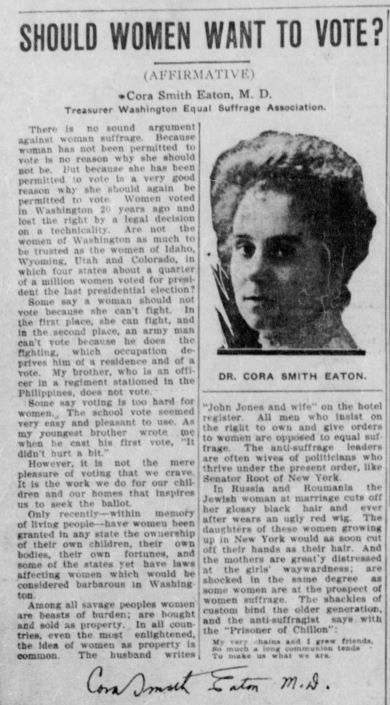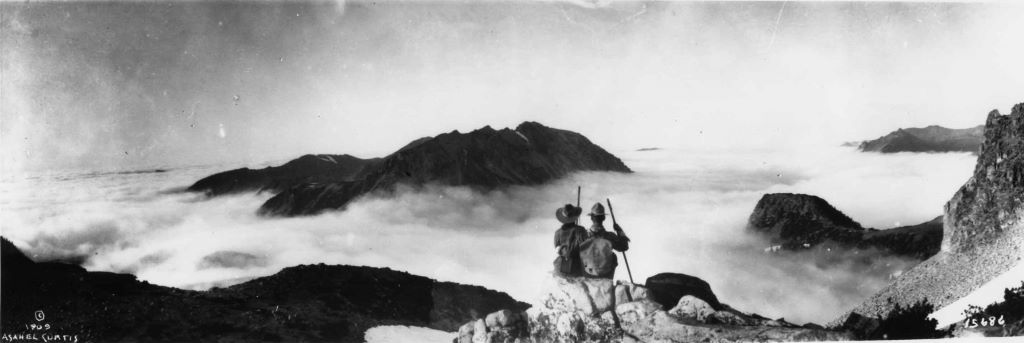On the summit of suffrage
Cora Smith Eaton King, local legend and member of UND’s first graduating class, took the fight for women’s suffrage to the top of the tallest mountain in Washington

The life of Cora Smith Eaton King was so rich and fantastic that it might seem ripped from the pages of a Hollywood screenplay.

One hardly could imagine a more inspiring graduate of UND if she’d been picked for the role by the 1880s version of Central Casting. Not only was she a member of UND’s inaugural graduating class in 1889, but she also became the first licensed woman physician in North Dakota.
Moreover, she became a nationally known advocate for the cause of women’s suffrage, an activist career that she started right here in Grand Forks. And in the course of her suffragist work, she often employed unconventional methods.
Including, most notably, planting a “Votes for Women” pennant on the 14,410-foot summit of Washington’s Mount Rainier.
It’s that mountaineering feat in 1909 — which drew national attention, and helped prompt Washington state the following year to grant women the right to vote — that is the focus of our story today.
A lifetime of suffrage advocacy
Cora Smith started her suffrage work at UND when she and her mother, Sara Smith, founded the Grand Forks Woman’s Suffrage Association.
Following her graduation from UND, a prominent suffrage advocate, Henry Blackwell, asked her to speak in his place at the North Dakota Constitutional Convention, where she lobbied for the inclusion of women’s suffrage in the state’s constitution. While unsuccessful, the mother and daughter would be the first women in Grand Forks to vote in a school election, the only voting rights women were allowed in the state.
 Years later in a column in the Seattle Star, she would reflect on her first vote while advocating for women’s suffrage in Washington.
Years later in a column in the Seattle Star, she would reflect on her first vote while advocating for women’s suffrage in Washington.
“Some say voting is too hard for women,” she wrote. “The school vote seemed very easy and pleasant to us. As my youngest brother wrote me when he cast his first vote, ‘It didn’t hurt a bit.’”
In the following years, she continued to rise as a prominent figure in North Dakota, becoming president of the North Dakota Suffrage Association and speaking before Congress on women’s suffrage. Soon after, she moved to Minnesota, where she lived for 10 years and also served as president of the state’s Suffrage Association.
After attending the National American Woman Suffrage Association convention in Portland, Ore., she moved from Minnesota to Seattle, where she continued to practice medicine and became a fixture in Washington state’s suffrage circles.
Over the next four years, she became deeply involved in Seattle’s suffrage movement, serving as treasurer of the Washington Equal Suffrage Association. Despite some heavily publicized tension between her group and a similar organization headquartered in Spokane, Wash., the Washington women successfully secured a vote for suffrage to be placed on the ballot for the state’s 1910 referendum.
Serendipitously, the year before the vote, Washington hosted its own world fair, the Alaska-Yukon-Pacific Exposition, on the campus of the University of Washington — an event that was expected to draw millions of visitors from around the nation and world. The National American Woman Suffrage Association strategically planned its annual convention for that same summer in Seattle, offering proponents of suffrage access to one of the largest platforms in the world.
Cora and the Mountaineers
Meanwhile, she was also a founding member of the Seattle Mountaineers Club and, along with other members of the group, organized a hike to the top of Mount Rainier to take advantage of the influx of tourists and suffragists coming to the state.
In addition to her other talents, she was an accomplished mountain climber. While living in Washington, she successfully climbed the state’s six major peaks and became the first woman to reach the East Peak of Mount Olympus in 1907.
Notably, she inscribed “Votes for Women” next to her name in the register at Glacier Peak.
Smith Eaton King and the Mountaineers invited the visiting suffragists, who had come to Seattle by the hundreds, to join them as they attempted to summit Mount Rainier. The goal was to claim the peak by planting a flag commemorating the A-Y-P exposition with a “Votes For Women” pennant fixed to the flagstaff.
On July 17, 70 men and women left a Seattle train station and traveled 40 miles south to Carbon River, where they began their hike and ascent. The three-week adventure included campouts at Moraine Park, a mile above sea level, to conduct test trips — preparations that the group’s photographer, Ashael Curtis, said many of the hikers found “irksome” but ultimately were useful to “test their mettle.”

Indeed, the test runs were a good idea. The route they’d planned on taking was described in an article in the Grand Forks Herald following the ascent, as were the treacherous conditions the Mountaineers had to brave to reach the mountain’s peak.
“In climbing Mount Rainier, the party took the new and previously untried northeastern side visible from Seattle by means of strong telescopes,” the article read. “It is a route which has been avoided by climbers and tourists because of its mystery, precipitous slopes and difficult passages.”
The Mountaineers had valid reasons to be apprehensive. Just two years earlier, an incident had occurred during the group’s 1907 hike to the peak of Mount Olympus.
An article in the Tacoma Daily Ledger described how a woman named Winona Bailey nearly died after falling 75 feet off a cliff. Smith Eaton King was also along for that trip, the article noted, and was the person who nursed Bailey until she could be carried to safety.
A treacherous trek to the peak
Thankfully, as the Mountaineers ascended to their first temporary resting spot on Mount Rainier, the only major incident they faced was the dislocation of photographer Curtis’ shoulder.
Only two party members turned back before they reached their camp. And perhaps those two should have stayed, because the party reportedly had a great evening in camp, a night that included recitations, storytelling, songs and “burlesque prize fights with pillows for boxing gloves,” according to Vancouver newspaper The Daily Advertiser.
Closer to the summit, though, the weather became rough and dangerous.
“Few could have stood alone on the slopes that now measured 45 degrees and ended in broken crevasses. Fewer still could have endured the strain of breaking steps in the hard snow, always with that white blur running upward to the blue sky, and downward until the eye grew dizzy following where miles away the ice and forest mingled. The only safety lay in watching the steps ahead and moving forward as the signal was given,” Curtis wrote in his summary of the trip for the second volume of “The Mountaineer” journal.
Many stopped short of their destination as they reached the mountain’s summit. Curtis recalls hearing one man say, “This is no place for the father of eight children.”
Smith Eaton King was among those undeterred and continued to the summit, where she planted the flagstaff with the “Votes For Women” pennant affixed. Unfortunately, strong winds swept the flag from its spot each time she planted it. Finally, the flagstaff snapped from the force, and they decided to leave the flag and pennant in a crevasse on top of the Columbia Crest.

A Seattle Post Intelligencer article noted that, upon their return, nearly 500 people greeted the Mountaineers. The stunt gained national attention and undoubtedly affected for the better the public perception of women’s suffrage.
As for the referendum the following year, support for women’s right to vote handily won over the opposition, making Washington the first state in more than a decade to grant women voting rights. This started a landslide of suffrage support, and 10 other states would grant women full voting rights before the passage of the 19th Amendment.
Smith Eaton King would continue to climb to dazzling heights in the years that followed. In 1913, she rode on horseback through the streets of Washington, D.C., as a part of a women’s suffrage march and met with President Woodrow Wilson to advocate for suffrage that same year. Among her many accomplishments though, none reached quite the heights of her triumph at Mount Rainier.



